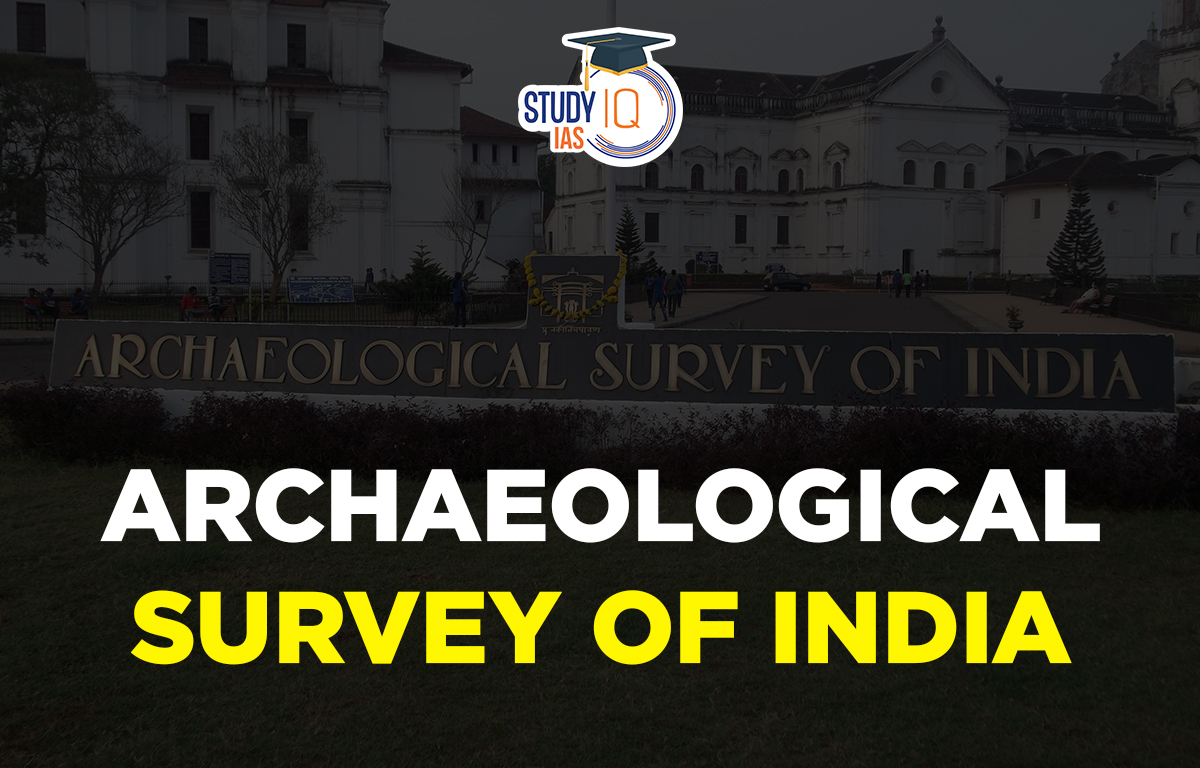Table of Contents
Archaeological Survey of India
The Archaeological Survey of India (ASI) is an Indian government agency in charge of archaeological research, conservation, and preservation of the country’s cultural heritage. The British government established it in 1861, and it is headquartered in New Delhi. This article will teach you about the Archaeological Survey of India’s major activities, functions, and roles, as well as the Archaeological Survey of India circles in India. This is critical for both the UPSC IAS exam art and culture section and the IAS Prelims exam government departments and ministries section.
Archaeological Survey of India Act
The Archaeological Survey of India, or ASI, is an attached agency of the Government of India’s Ministry of Culture. Through the provisions of the Ancient Monuments and Archaeological Sites and Remains Act (AMASR Act), 1958, ASI regulates all archaeological activities in the country. It also governs the Antiquities and Art Treasure Act of 1972. James Cunningham, a British Army engineer with a keen interest in archaeology in India, founded it in 1861.
Archaeological pursuits began much earlier, in the 18th century, with the formation of the Asiatic Society in 1784 by Sir William Jones and a group of antiquarians. Following independence, it became a statutory body under the AMASR Act of 1958.
Archaeological Survey of India Headquarters
The Archaeological Survey of India is headquartered in New Delhi and operates regional offices across the country. To carry out its mandate, it employs archaeologists, conservationists, architects, historians, and other experts from various fields. The Archaeological Survey of India has divided the country into roughly 30 circles in order to maintain monuments and conduct archaeological work.
Archaeological Survey of India Circles
The Archaeological Survey of India has divided the country into approximately 30 circles for the purpose of maintaining monuments and carrying out archaeological work. The table below contains a list of Archaeological Survey of India circles as of March 2023. Apart from the below ones, there is a mini circle Leh (UT of Ladakh).
| Agra | Aizawl | Amravati |
| Aurangabad | Bangalore | Bhopal |
| Bhubaneswar | Chandigarh | Chennai |
| Dehradun | Delhi | Dharwad |
| Goa | Guwahati | Hampi |
| Hyderabad | Jabalpur | Jaipur |
| Jhansi | Jodhpur | Kolkata |
| Lucknow | Mumbai | Meerut |
| Nagpur | Patna | Raipur |
| Rajganj | Rajkot | Ranchi |
| Sarnath | Shimla | Srinagar |
| Thiruchirapalli | Thrissur | Vadodara |
First Director General of Archaeological Survey of India
The First Director General of the Archaeological Survey of India (ASI) Alexander Cunningham. From 1861 to 1865, he was the Director General of the Archaeological Survey of India. Cunningham is regarded as the Archaeological Survey of India’s founder and is credited with laying the groundwork for Indian archaeology. He conducted extensive archaeological explorations and excavations throughout India, resulting in the discovery of several significant historical sites and monuments.
Cunningham’s contribution to Indian archaeology has been widely recognised, and he is regarded as one of the field’s pioneers. Alexander Cunnigham is also known as the ‘Father of Indian Archaeology’. V. Vidyavathi is the present Director General of the Archaeological Survey of India.
Indian Archaeological Survey
The primary mission of the Archaeological Survey of India is to survey, excavate, conserve, and maintain India’s ancient monuments and archaeological sites. The organization’s mission is to preserve India’s rich cultural heritage, which includes historic structures, temples, forts, and monuments.
Aside from conservation and preservation work, the Archaeological Survey of India also conducts Indian Archaeological Survey, archaeological excavations and research to better understand India’s past. The organisation is also in charge of managing and maintaining museums, libraries, and archives containing artefacts and documents from India’s ancient past. The Archaeological Survey of India has made numerous significant discoveries and contributions to archaeology over the years.
In addition to research and conservation, the Archaeological Survey of India is active in raising public awareness and education about India’s heritage. It accomplishes this through the organisation of exhibitions, the publication of research papers, and the conduct of guided tours of historical sites and monuments.
Overall, the Indian Archaeological Survey plays an important role in India’s efforts to preserve and celebrate its rich cultural heritage.
Archaeological Survey of India UPSC
The Archaeological Survey of India (ASI) is an important topic for the UPSC (Union Public Service Commission) exam, particularly the Indian History and Culture paper. UPSC is an Indian competitive examination that selects candidates for various civil services such as the Indian Administrative Service (IAS), the Indian Police Service (IPS), and the Indian Foreign Service (IFS).
Aspirants for the UPSC exam should have a good understanding of Indian history and culture, as well as the role of the Archaeological Survey of India in preserving and protecting India’s cultural heritage.
Candidates should be familiar with the following Archaeological Survey of India -related topics:
- The Archaeological Survey of India’s history, including its founding, goals, and accomplishments.
- The ASI’s role in preserving and protecting India’s cultural heritage, which includes monuments, sculptures, paintings, and other artefacts.
- The Archaeological Survey of India has excavated and preserved important archaeological sites and monuments in India.
The difficulties that the Archaeological Survey of India has encountered in its efforts to preserve India’s cultural heritage include funding, manpower, and coordination with other government agencies.
Candidates should also be aware of the Archaeological Survey of India’s recent initiatives, such as the use of modern technology for archaeological excavations and the establishment of museums to highlight India’s rich cultural heritage.


 Daily Quiz 25 April 2025
Daily Quiz 25 April 2025
 UPSC Marks 2025 Out – Download UPSC Ma...
UPSC Marks 2025 Out – Download UPSC Ma...
 Best Optional Subject for UPSC, Check Sc...
Best Optional Subject for UPSC, Check Sc...





















